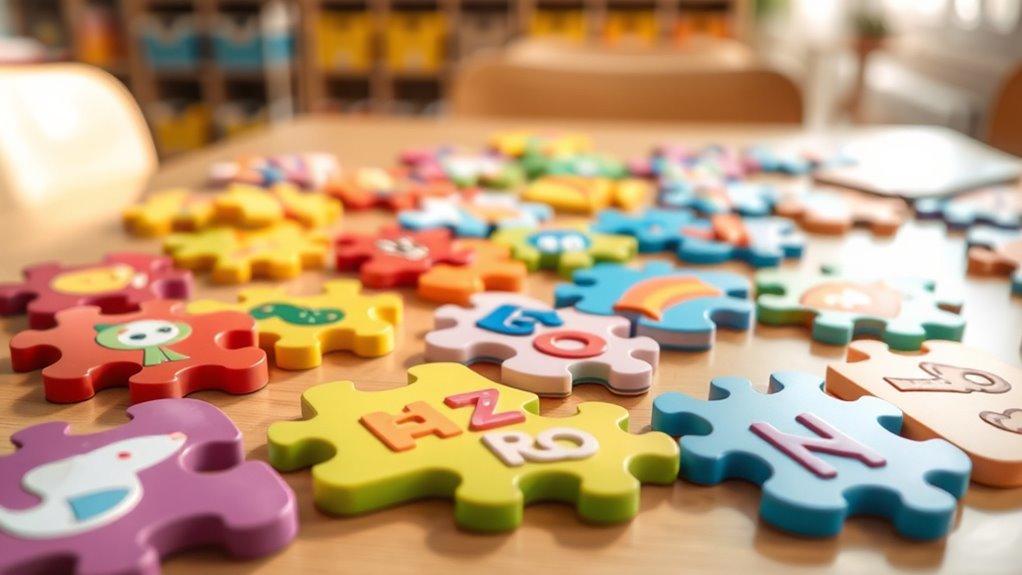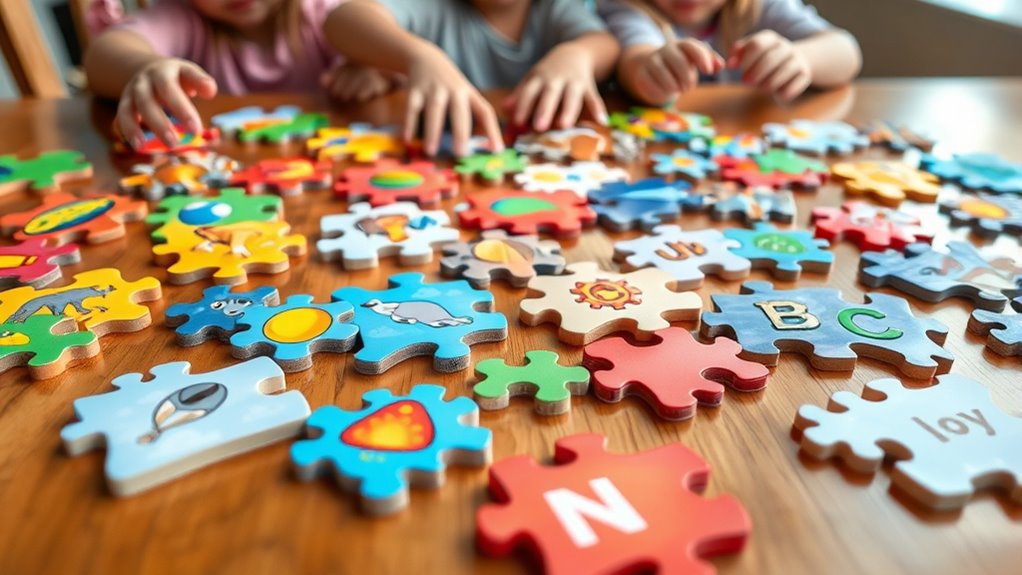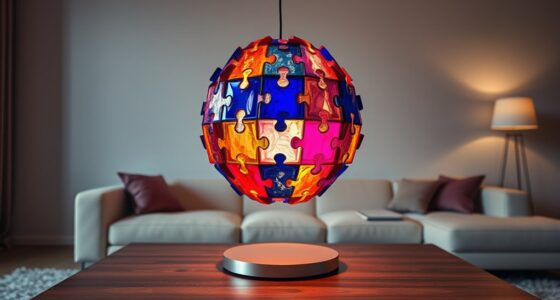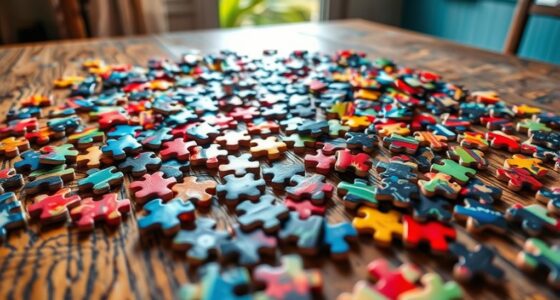Educational puzzle designs are fantastic tools that boost skills like critical thinking, memory, and problem-solving while making learning fun. Whether it’s matching shapes for young kids or complex logic riddles for older learners, these puzzles adapt to different ages and developmental stages. They can also incorporate themes like sustainability to teach environmental awareness. Keep exploring to discover more ways to create engaging puzzles that foster both cognitive growth and important values effortlessly.
Key Takeaways
- Design puzzles that target specific cognitive skills like pattern recognition, critical thinking, and problem-solving for effective learning.
- Incorporate age-appropriate complexity, from simple shape-sorting for young children to advanced logic riddles for older learners.
- Use thematic puzzles related to sustainability and environmental awareness to integrate educational content with cognitive development.
- Ensure puzzles promote perseverance and resilience by providing appropriately challenging tasks that encourage persistence.
- Combine visual, linguistic, and strategic puzzle formats to support diverse learning styles and foster comprehensive cognitive growth.

Educational puzzle designs are powerful tools that make learning engaging and interactive. When you incorporate puzzles into education, you tap into a child’s natural curiosity and love for problem-solving. These puzzles do more than entertain; they substantially impact brain development by stimulating neural pathways associated with reasoning, memory, and attention. As you present children with various puzzle formats, you’re helping to strengthen their cognitive skills—such as critical thinking, pattern recognition, and spatial awareness. These skills are essential for academic success and everyday problem-solving, making puzzles a valuable addition to any learning environment.
Puzzles boost brain development and cognitive skills through engaging, interactive learning experiences.
When you design puzzles that require kids to analyze, plan, and strategize, you’re encouraging active mental engagement. This interaction promotes faster development of the brain’s neural connections, which is essential during early childhood but continues to benefit learners of all ages. For example, puzzles that involve matching shapes or assembling pieces challenge children to recognize visual patterns, boosting their visual-spatial skills. These skills are foundational for subjects like math, science, and even reading, as they enhance the ability to understand relationships between objects and concepts.
Furthermore, puzzle designs that incorporate language elements, such as word puzzles or riddles, help expand vocabulary and improve language comprehension. When you create puzzles that require decoding or forming words, you’re fostering literacy skills in a fun and memorable way. The challenge of solving these puzzles also builds perseverance and patience, which are indispensable traits for lifelong learning. As children work through different levels of difficulty, they’ll learn to manage frustration, develop resilience, and celebrate small victories—traits that are just as important as the cognitive skills they acquire.
You can also enhance brain development by tailoring puzzles to different age groups and developmental stages. For younger children, simple shape-sorting or matching puzzles introduce basic concepts of logic and categorization. For older children and adults, more complex puzzles like Sudoku or logic riddles push their reasoning abilities further, encouraging advanced problem-solving strategies. By varying puzzle difficulty and type, you guarantee continuous cognitive growth and keep learners motivated.
In addition, incorporating environmentally conscious puzzle designs can teach children about sustainability and conservation through thematic challenges and educational content. By doing so, you’re not only fostering cognitive development but also promoting awareness of important environmental issues. In essence, educational puzzle designs serve as dynamic tools that foster brain development and hone cognitive skills. They transform passive learning into an active, enjoyable experience, making complex ideas more accessible and memorable. When you use puzzles thoughtfully, you’re not just helping children learn facts—you’re cultivating their ability to think critically, reason abstractly, and approach challenges with confidence. These skills will serve them well beyond the classroom, empowering them to navigate the complexities of everyday life with creativity and clarity.
Frequently Asked Questions
How Do Puzzles Improve Problem-Solving Skills?
Puzzles improve your problem-solving skills by challenging your spatial reasoning and boosting cognitive development. As you work through different puzzles, you learn to analyze patterns, think critically, and develop strategies. These activities help you recognize connections and improve mental flexibility. The more you engage with puzzles, the better you become at tackling complex problems, sharpening your mind, and enhancing your overall problem-solving abilities.
What Age Groups Benefit Most From Educational Puzzles?
You’ll find that educational puzzles benefit children most during early childhood and elementary years, as they support age-appropriate challenges that align with cognitive development. These puzzles help boost problem-solving, fine motor skills, and critical thinking, making learning engaging and effective. As you choose puzzles suited to different age groups, you guarantee each child gets the right level of difficulty to foster growth and confidence.
Are There Digital Versions of Educational Puzzles?
Yes, there are digital versions of educational puzzles available on various digital platforms. You can explore interactive apps that make learning engaging and fun, offering puzzles tailored to different age groups. These apps often include features like hints and progress tracking, helping you stay motivated. Using digital puzzles, you can learn anytime, anywhere, and enjoy a variety of topics while developing critical thinking and problem-solving skills.
How Can Teachers Incorporate Puzzles Into Lessons?
You can incorporate puzzles into lessons by using interactive storytelling, which engages students actively and makes learning fun. During a creative workshop, challenge students to solve puzzles that relate to the lesson topic, encouraging critical thinking and collaboration. Incorporate digital puzzles for diverse learning styles, and always align them with your objectives. This approach keeps students motivated and helps reinforce key concepts effectively.
What Materials Are Best for Durable Puzzle Design?
You should choose materials like thick cardboard, durable plastic, or laminated wood for puzzle design, as they offer excellent material durability. Use sturdy assembly techniques such as interlocking pieces, reinforced edges, and strong adhesives to guarantee longevity. These choices make your puzzles resistant to wear and tear, allowing repeated use. By focusing on durable materials and solid assembly methods, you create educational puzzles that last and provide ongoing learning opportunities.
Conclusion
By integrating puzzles into your teaching, you open a world of endless curiosity and learning. These designs aren’t just games—they’re powerful tools that can make even the most complex topics feel like a walk in the park. Imagine turning your classroom into an epic adventure where students enthusiastically solve challenges at lightning speed. Embrace educational puzzles, and watch your students’ minds explode with knowledge—becoming smarter than you ever dreamed possible!









